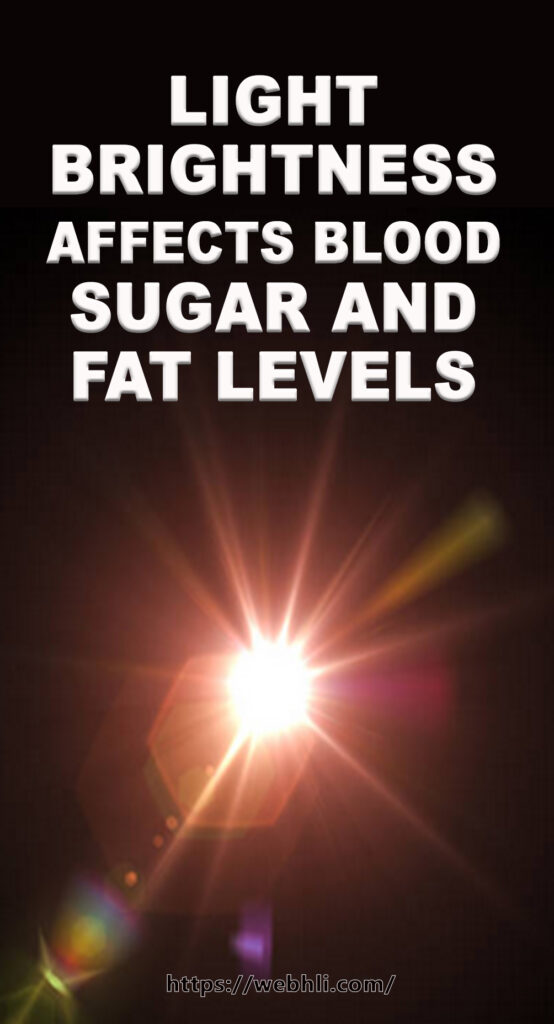
According to the Journal of Biological Rhythms, April 2017, the amount of light we see in the morning can affect our blood sugar and fat levels. Scientists at the University of Amsterdam and several other research institutions in the Netherlands compared Type 2 diabetic men with non-diabetic men exposed to either dim or bright light at 0730. Eight lean, healthy men and eight males who had been diagnosed with Type 2 diabetes were exposed to either 4000 lux or 10 lux of light for an hour. Each participant was given a 600 calorie breakfast.
In the non-diabetic males, a bright light did not affect their blood sugar levels before or after breakfast, but it did raise their blood fats before and after the meal. The males with Type 2 diabetes showed an increase in their blood sugar levels before and after breakfast when they were exposed to bright light. Bright light did not affect blood fat levels in the diabetic men before breakfast but it did increase these levels afterward. From these results, the researchers concluded the effect of light should be further researched in the interest of diagnosis and prevention of Type 2 diabetes and high blood fats.
Check out these related articles, too:
How Resistance Training Can Help You Heal Diabetes
Diabetic Breakfast Meal Planning, Truth Revealed!
Weight Loss and Blood Sugar Control
Arthritis And Diabetes - A Double Whammy
What Is Diabetic Gastroparesis?
Healthy Lifestyle Tips For Type 2 Diabetes
Does protein increase blood glucose levels?
How Does Diabetes Affect My Teeth and Gums?
Lux is a measure of light brightness. An example would be 3.4 lux at twilight or 20 to 50 lux in a lighted public area surrounded by darkness. An overcast day would have 1000 lux, while full daylight would have between 10,000 and 25,000 lux. Perhaps eating breakfast indoors with a dim light would help control blood sugar levels.
Human beings are diurnal, meaning we are awake during the day, as opposed to nocturnal creatures who stay awake at night. When light enters our eyes, photoreceptors signal the brain it is morning and time to wake up. This is part of our circadian, or 24-hour rhythm. It includes...
- waking,
- sleeping,
- hormones,
- body temperature, and
- several other functions.
When our circadian rhythm does not work correctly, sleep disorders such as insomnia can occur...
- Type 2 diabetes,
- obesity, and
- depression.
- Bipolar disorder (manic-depressive disorder) and seasonal affective disorder, in which depression occurs during winter, are all related to abnormal circadian rhythms.
Jet lag is due to abnormal exposure to light and darkness, night and day. Travelers can become overly tired and lose their appetites.
According to the National Institutes of Health in the United States, our body...
- is most sensitive to the glucose concentration in the early morning, releasing insulin as needed.
- the hormone cortisol is released in the morning and raises blood sugar levels.
Well-balanced circadian rhythms require several organs working in tandem, and light has a great deal to do with it.
Although managing your disease can be very challenging, Type 2 diabetes is not a condition you must just live with. You can make simple changes to your daily routine and lower both your weight and your blood sugar levels. Hang in there, the longer you do it, the easier it gets.
Check out these related articles, too:
Good Energy Food for Diabetics
10 Simple Food Concepts Every Person Living With Diabetes Should Know
Making Cheesecake For Diabetics
Enjoy the Taste and Benefits of Diabetic Foods
Will The Mulberry Leaf Help Your Diabetes?
5 DIABETIC FRIENDLY SALADS Some Tasty
DIABETIC LEMON COCONUT COOKIES Some Tasty
DIABETIC BANANA BREAD Some Tasty
For nearly 25 years, Beverleigh Piepers has searched for and found a number of secrets to help you build a healthy body. Go to http://DrugFreeType2Diabetes.com to learn about some of those secrets.
The answer isn't in the endless volumes of available information but in yourself.
Article Source: http://EzineArticles.com/9709107

 Protected by Patchstack
Protected by Patchstack